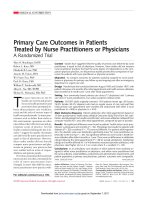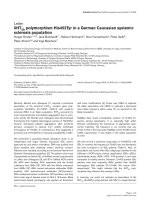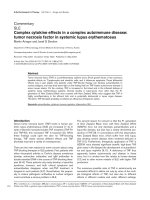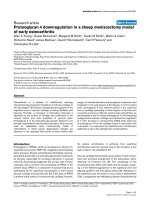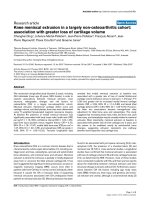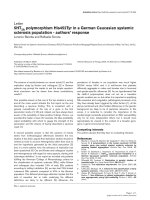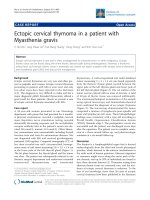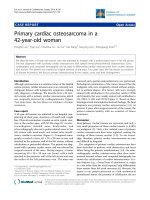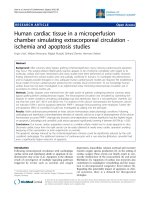Báo cáo y học: " Clavicular stress fracture in a cricket fast bowler: A case report" docx
Bạn đang xem bản rút gọn của tài liệu. Xem và tải ngay bản đầy đủ của tài liệu tại đây (255.69 KB, 3 trang )
BioMed Central
Page 1 of 3
(page number not for citation purposes)
Journal of Medical Case Reports
Open Access
Case report
Clavicular stress fracture in a cricket fast bowler: A case report
Jeremy AF Read*
1
and Phillip Bell
2
Address:
1
Royal Surrey County Hospital, Egerton Road, Guildford, Surrey, GU27XX, UK and
2
BUPA Wellness Centre, White Lyon Court, Barbican,
London, EC2Y 8EY, UK
Email: Jeremy AF Read* - ; Phillip Bell -
* Corresponding author
Abstract
Introduction: Whilst rare, stress fractures of the clavicle have been described in other sports. To
our knowledge, this is the first reported case of a stress fracture of the clavicle occurring in a
cricket fast bowler.
Case presentation: A 23-year-old professional cricket fast bowler presented with activity related
shoulder pain. Imaging demonstrated a stress fracture of the lateral third of the clavicle. This healed
with rest and rehabilitation allowing a full return to professional sport.
Conclusion: This injury is treated with activity modification and technique adaptation. In a
professional sportsman, this needs to be recognised early so that return to play can be as quick as
possible.
Introduction
This case presents an international level cricketer who
developed an activity related shoulder pain which, after
investigation, was demonstrated to be a stress fracture of
the lateral clavicle. Stress fractures are well recognised in
athletes, particularly in weight bearing bones and are
often related to changes in training regime or intensity.
Stress fracture of the clavicle is, however, an unusual
injury and has not been described in this sporting group.
Case presentation
A 23-year-old professional right-handed fast bowler pre-
sented with a 4-month history of presumptive bowling
related right shoulder and upper anterior chest pain that
was eased by rest. A winter season of low intensity cricket
and high intensity weight training in Australia, plus a
bowling symposium in India was followed by twice daily
60-minute bowling practice sessions during which he
started to experience pain. A rheumatologist found no
abnormal clinical signs and a thoracic spine MRI was
reported as normal.
Clinical examination (PB) revealed mildly protracted
shoulders, with minor functional winging of the scapular
and weakness of the supraspinatus. The pectoralis minor
was also tight. Shoulder range of motion was full, cervical
spine examination was normal as were subacromial
impingement tests, acromioclavicular stress tests and
superior labrum anterior and posterior (SLAP) provoca-
tion tests. The glenohumeral joint was stable to examina-
tion and there was bony tenderness over the lateral end of
the clavicle.
A single photon emission computed tomography
(SPECT) scan demonstrated a focus of increased uptake in
the lateral third of the clavicle (Fig. 1) and a CT scan (Fig.
2) that revealed sclerosis and a lucent line with associated
sclerosis confirmed a stress fracture.
Published: 19 September 2008
Journal of Medical Case Reports 2008, 2:306 doi:10.1186/1752-1947-2-306
Received: 28 August 2007
Accepted: 19 September 2008
This article is available from: />© 2008 Read and Bell; licensee BioMed Central Ltd.
This is an Open Access article distributed under the terms of the Creative Commons Attribution License ( />),
which permits unrestricted use, distribution, and reproduction in any medium, provided the original work is properly cited.
Journal of Medical Case Reports 2008, 2:306 />Page 2 of 3
(page number not for citation purposes)
He was rested from bowling and upper body weight train-
ing and rehabilitated with emphasis on scapular stability
and rotator cuff strengthening until there was no residual
local bony tenderness and he was asymptomatic with
press-ups. He returned to professional cricket without
recurrence.
Discussion
Stress fractures are common in a sporting population,
accounting for over 20% of all fractures in collegiate ath-
letes [1]. In cricket, fast bowlers are at risk of stress frac-
tures of the pars interarticularis [1,2] related to incorrect
technique, overuse, and poor preparation, but, to our
knowledge, stress fracture of the clavicle has never been
reported in cricketers.
Stress fracture of the clavicle has been reported, following
radical neck dissection [3], in a Catalan, human tower
builder who had other team members standing on his
shoulders [4], and a 'cable-maker' who spent his day lift-
ing a heavy drum on his shoulder whilst tightening bolts
several hundred times a day [5]. There are also reported
cases in sports including a gymnast [6], a diver using an
open hand water entry technique [7], a light weight sculler
[8], a baseball 3rd base man [9], and a weight lifter [10],
but none from cricket.
A stress fracture is a fatigue failure of bone and, as such,
can result from repeated unusual, unopposed or uncoor-
dinated loading. It can be proposed that the unopposed
action of muscles acting at the lateral clavicle following
radical neck dissection predisposed this patient to stress
fracture. Repetitive direct loading of the bone in the cable
maker and the tower builder as well as the repetitive tor-
sional loading experienced by the diver indicate the possi-
ble aetiology in these cases. In the other cases, there are
multiple factors that may have resulted in bone failure, for
example, the intensity and nature of training and issues
with technique and execution of their sport's specific
activity.
There are several factors that may have contributed to the
development of this injury in our patient, notably the
intensity of net training and the increased level of upper
body gym work that he was undertaking. There was mus-
cle imbalance around his shoulder girdle that was
addressed during rehabilitation, and though technical
issues with his bowling were not directly considered, he
underwent formal technical analysis on returning to his
team.
It is possible to propose a mechanism for the develop-
ment of this injury. It possibly relates to the activity of the
anterior deltoid and pectoralis major on the inferior
aspect of the clavicle, counteracted by the action of the tra-
pezius and sternocleidomastoid acting isometrically. This
is the mechanism hypothesised to have caused this injury
in the rower. Alternatively, it could be the strut effect of
the clavicle supporting the shoulder being heavily axially
loaded during the overhead phase of the bowling action
when it is almost vertical. This could then result in a bend-
ing force, leading to eventual failure.
Conclusion
Clavicular stress fracture is a rare entity and it is not possi-
ble to determine the specific aetiology in this patient.
However, recognition of the injury, rest and subsequent
rehabilitation allowed him to return to top-level sport.
Clavicular stress fracture should be considered in the dif-
ferential diagnosis of a cricket fast bowler presenting with
Single photon emission computed tomography scan of shoul-dersFigure 1
Single photon emission computed tomography scan
of shoulders. A single photon emission computed tomogra-
phy scan showing increased uptake in the lateral clavicle con-
sistent with the site of pain.
Computed tomography scan of clavicleFigure 2
Computed tomography scan of clavicle. Computed
tomography slice showing lucent line (arrowed) with adja-
cent sclerosis consistent with healing stress fracture.
Publish with BioMed Central and every
scientist can read your work free of charge
"BioMed Central will be the most significant development for
disseminating the results of biomedical research in our lifetime."
Sir Paul Nurse, Cancer Research UK
Your research papers will be:
available free of charge to the entire biomedical community
peer reviewed and published immediately upon acceptance
cited in PubMed and archived on PubMed Central
yours — you keep the copyright
Submit your manuscript here:
/>BioMedcentral
Journal of Medical Case Reports 2008, 2:306 />Page 3 of 3
(page number not for citation purposes)
bowling related shoulder and upper anterior chest pain in
the dominant arm.
Consent
Written informed consent was obtained from the patient
for publication of this case report and accompanying
images. A copy of the written consent is available for
review by the Editor-in-Chief of this journal.
Competing interests
The authors declare that they have no competing interests.
Authors' contributions
PB was the treating clinician, while JR performed the back-
ground research and write up.
References
1. Hame SL, LaFemina JM, McAllister DR, Schaadt GW, Dorey FJ: Frac-
tures in the collegiate athlete. Am J Sports Med 2004,
32(2):446-451.
2. Bell PA: Spondylolysis in fast bowlers: principles of prevention
and a survey of awareness among cricket coaches. Br J Sports
Med 1992, 26(4):273-275.
3. Hao SP, Chang PT: Stress fracture of the clavicle after selective
neck dissection. Otolaryngol Head Neck Surg 1998, 118(5):732-733.
4. Roset-Llobet J, Salo-Orfila JM: Sports-related stress fracture of
the clavicle: a case report. Int Orthop 1998, 22(4):266-268.
5. Peebles CR, Sulkin T, Sampson MA: 'Cable-maker's clavicle':
stress fracture of the medial clavicle. Skeletal Radiol 2000,
29(7):421-423.
6. Fallon KE, Fricker PA: Stress fracture of the clavicle in a young
female gymnast. Br J Sports Med 2001, 35(6):448-449.
7. Waninger KN: Stress fracture of the clavicle in a collegiate
diver. Clin J Sport Med 1997, 7(1):66-68.
8. Abbot AE, Hannafin JA: Stress fracture of the clavicle in a
female lightweight rower. A case report and review of the
literature. Am J Sports Med 2001, 29(3):370-372.
9. Wu CD, Chen YC: Stress fracture of the clavicle in a profes-
sional baseball player. J Shoulder Elbow Surg 1998, 7(2):164-167.
10. Shellhaas JS, Glaser DL, Drezner JA, Shellhaas JS, Glaser DL, Drezner
JA: Distal clavicular stress fracture in a female weight lifter: a
case report. Am J Sports Med 2004, 32(7):1755-1758.
